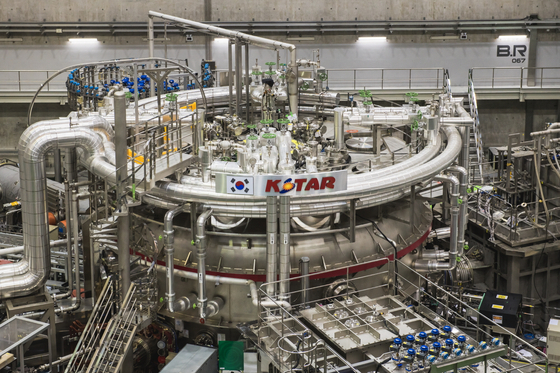Energy
S.Korea to design proven type reactor of nuclear fusion power
The government aims to complete demo of 500 MW proven type reactor by 2035
By Jun 07, 2023 (Gmt+09:00)
1
Min read
Most Read
LG Chem to sell water filter business to Glenwood PE for $692 million


KT&G eyes overseas M&A after rejecting activist fund's offer


Mirae Asset to be named Korea Post’s core real estate fund operator


StockX in merger talks with Naver’s online reseller Kream


Meritz backs half of ex-manager’s $210 mn hedge fund



South Korean government has initiated the design phase for a nuclear fusion power proven type reactor, taking a significant step toward harnessing nuclear fusion for electricity generation.
The facility, intended for demonstration purposes, is expected to achieve an output level suitable for commercial operation.
The Ministry of Science and ICT said on Wednesday that a design preparation task force comprising industry and academia experts will be responsible for designing the 500-megawatt facility.
The preliminary conceptual design is scheduled for completion in 2026 as the first phase, followed by the establishment of design standards in the second phase by 2030. The engineering design and licensing process is projected to be concluded by 2035.
Nuclear fusion, which mimics the principle of the sun's energy production, involves the fusion of light atomic nuclei into heavier ones, generating substantial heat that can be utilized as an energy source. Unlike nuclear fission, this process eliminates concerns about radioactive emissions. With its potential to revolutionize energy sources, nuclear fusion is widely regarded as a game-changer.
The Korea Institute of Fusion Energy (KFE) has been actively researching nuclear fusion since the installation of the Korea Superconducting Tokamak Advanced Research (KSTAR) at the Daedeok Research Complex in Daejeon, Augist 2007. Their efforts have been focused on achieving and sustaining plasma temperatures above 100 million degrees Celsius, a crucial prerequisite for successful nuclear fusion.
Recent progress has seen plasma temperatures exceed 100 million degrees Celsius and remain stable for a duration of 30 seconds. The ultimate objective is to progressively extend this duration, targeting a milestone of more than 300 seconds by 2026.
Going beyond the capabilities of KSTAR, the upcoming demonstration facility will also encompass the development of devices such as steam generators and turbine generators, enabling electricity generation in conjunction with the fusion device.
The Ministry of Science and ICT anticipates the participation of approximately 20 companies, including those involved in the construction of KSTAR, in the design preparation team.
Write to Jin-Won Kim at jin1@hankyung.com
More to Read
-

-
 Business & PoliticsKorea starts building Shin Hanul, reviving aim to be nuclear powerhouse
Business & PoliticsKorea starts building Shin Hanul, reviving aim to be nuclear powerhouseMay 15, 2023 (Gmt+09:00)
3 Min read -
 EnergyS.Korea, US advised to cooperate in advanced nuclear power plant
EnergyS.Korea, US advised to cooperate in advanced nuclear power plantMay 03, 2023 (Gmt+09:00)
2 Min read -
 EnergySamsung Heavy forms int'l consortium to make nuclear plants at sea
EnergySamsung Heavy forms int'l consortium to make nuclear plants at seaApr 21, 2023 (Gmt+09:00)
1 Min read -

-
 EnergyKorea’s small nuclear reactor technology falls behind global peers
EnergyKorea’s small nuclear reactor technology falls behind global peersMar 31, 2023 (Gmt+09:00)
3 Min read -
 EnergyHyundai Eng. promotes MMR nuclear power plant project in Poland
EnergyHyundai Eng. promotes MMR nuclear power plant project in PolandFeb 09, 2023 (Gmt+09:00)
1 Min read -
 PerspectivesKorea’s nuclear power: Ample export opportunities ahead
PerspectivesKorea’s nuclear power: Ample export opportunities aheadJan 30, 2023 (Gmt+09:00)
4 Min read
Comment 0
LOG IN


